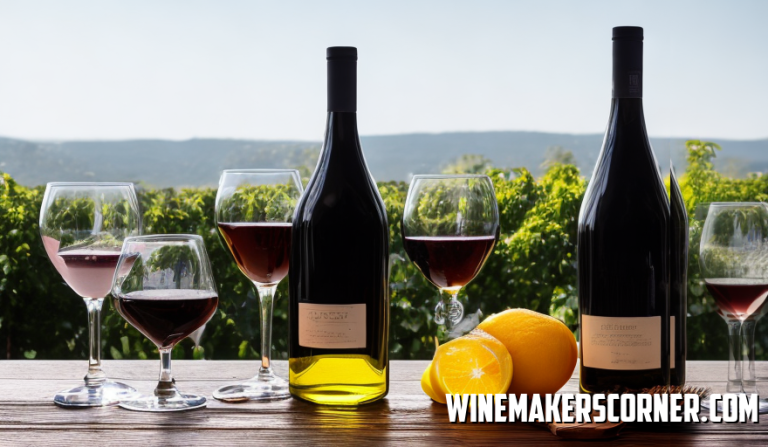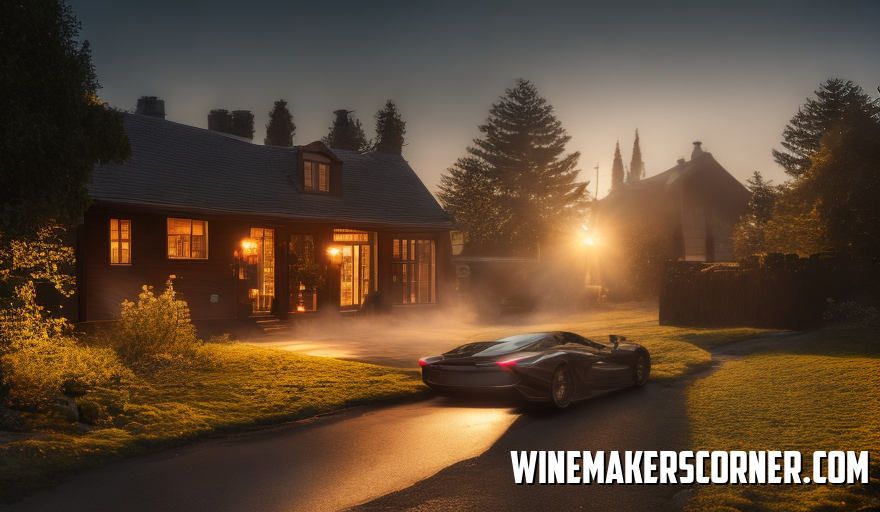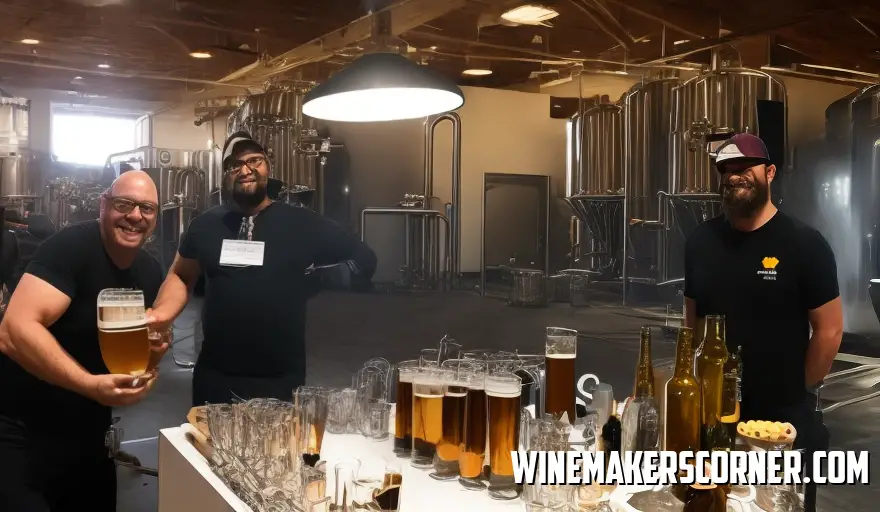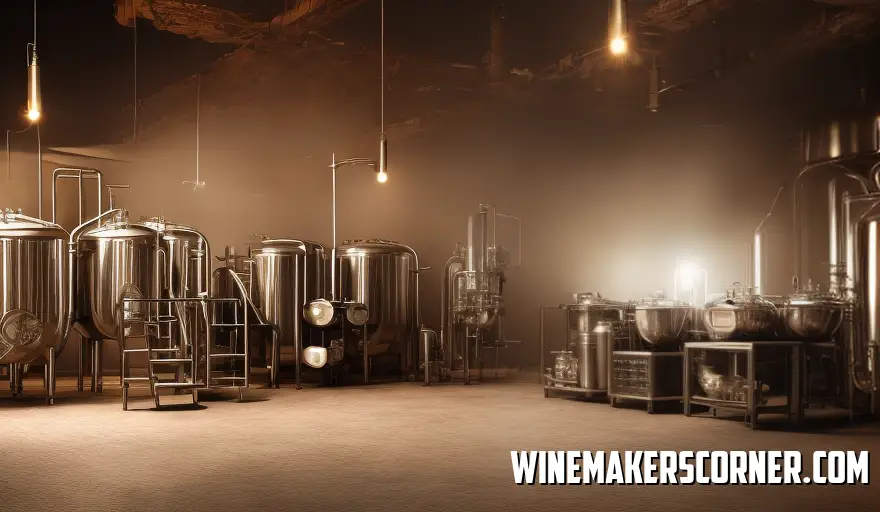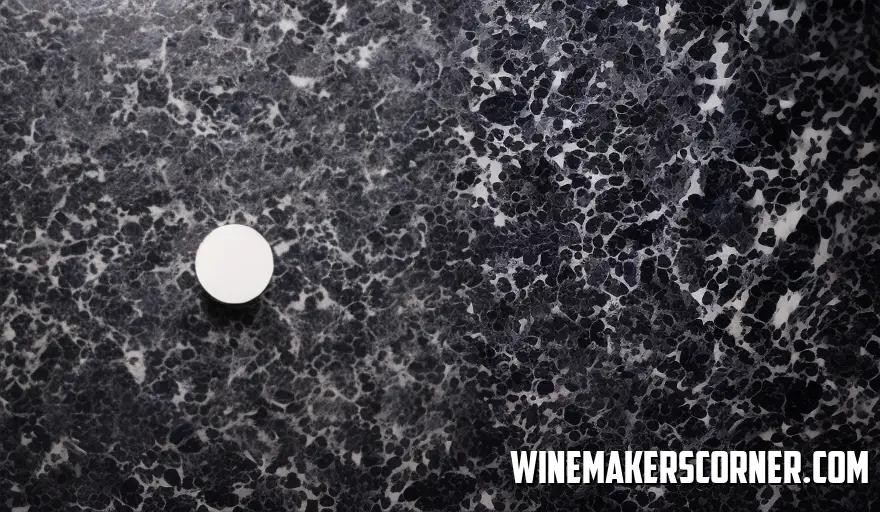For those who appreciate wine, there’s nothing quite like savoring a well-aged vintage – an elegant symphony of nuanced flavors and fragrances that have developed beautifully over time. But did you know that you can create a similar experience in your home?
Yes indeed! Come on an exciting journey as we explore the science behind aging homemade wine to achieve absolute perfection. We’ll dive deep into the delicate balance of tannins and acidity, guide ideal storage conditions, and teach you to recognize when your masterpiece has reached its zenith.
So let’s quench our thirst for knowledge as we embark on this vinous odyssey!
Table of Contents
Understanding the Aging Process
Achieving optimal results when aging homemade wine takes both patience and expertise. Properly aged wine has enhanced flavors and complexities, but it’s not just about letting the bottle sit on a shelf for years. Wine aging involves various factors that contribute to this transformation.
Chemical reactions involving acids, sugars, and tannins occur during wine aging within the wine itself; meanwhile, oxygen also plays an essential role by seeping into the bottle through tiny pores in cork or closure systems which helps mellow out tannins and deepen flavors.
The temperature remains crucial for successfully aged homemade wines – a constant cool temperature of around 55°F will maintain your brew’s integrity over time without leading to spoilage or any unwanted taste changes caused by fluctuations in temperature. Furthermore, humidity is another essential factor to consider. Too little moisture can lead to dry corks allowing too much oxygen into the bottle, whereas too much humidity promotes mold growth. Aging your homemade wine isn’t merely about leaving it in storage for an indefinite amount of time; it requires careful consideration of various factors before determining the ideal duration for maturation.
These factors include grape variety, fermentation method used, and personal preference – all contributing to the intricate decision-making process.
Short-term aging (6 months -2 years) may be suitable for specific wines, while others flourish with extended maturation periods (5 20 years). Lighter white wines typically don’t require prolonged aging as they have lower tannin content; by contrast, full-bodied reds require longer durations before reaching their peak potential.
Nevertheless, exceptional cases like Chardonnay or Riesling white wines can gracefully age for several years when stored suitably in optimal conditions.
In conclusion, producing homemade wine that tastes divine requires understanding the aging process’s intricacies.
The perfect blend of time temperature and oxygen storage is crucial in unlocking your wine’s full potential and achieving the desired divine taste. Remember to consider these variables as you explore a range of aging times to pinpoint the ideal fit for your particular taste.
With growing knowledge and experience comes an increased admiration for the artistry of wine aging, elevating your enjoyment of this enduring pursuit.
Choosing the Right Wine for Aging
The art of creating an exceptional taste lies in choosing the right wine for aging – a process that can elevate even mediocre bottles into exquisite ones. However, not all wines are suitable for long-term storage or extensive aging periods; thus, choosing wisely based on the grape variety and quality is crucial. Grape variety plays an integral role when deciding which types of wine to age – certain varieties possess qualities that make them more suitable for long-term storage than others. Classic red grapes that can be aged beautifully include Cabernet Sauvignon, Merlot, and Pinot Noir. At the same time, Chardonnay or Riesling are great options for white wines due to their high acidity levels.
In addition to grape variety, quality is another critical factor when considering which bottles of wine will benefit from further aging time. High-quality wines have better balance and structure – two elements necessary for a successful maturation process. To ensure you’re choosing suitable bottles of wine, seek out reputable producers with a reputation for making age-worthy wines; this approach will help guarantee that your investment yields fruitful results. To ensure success in making homemade wine, one must consider vintage variation – some years produce better wines than others due to favorable growing conditions leading up to optimal ripeness and flavor development. Consequently, it’s crucial that before purchasing any chosen wine, you research its specific vintage first for assurance of excellent quality.
Proper storage is also essential for graceful aging that brings out the best in your homemade wine; keeping bottles consistently at ideal temperature levels in a cool dark place while avoiding direct sunlight or fluctuating temperatures can prevent damage from occurring to your precious investment. Finally, let’s talk about patience – vital when aging homemade wines because how long you wait will depend upon various factors like grape variety, vintage quality, and individual taste preferences, but as a general rule of thumb, allow at least five years for reds or three years for whites gives adequate time before tasting periodic. In conclusion: careful consideration given to factors like grape variety, quality, vintage variation, and personal taste preferences when selecting the right wine for aging can provide a divine taste-making experience that, with patience and dedication, yields perfectly aged homemade wine.
Aging gracefully involves embracing its many advantages with an open heart. Recent studies have found that having a positive mindset regarding the aging process dramatically improves physical and mental health outcomes.
Those who approach aging optimistically demonstrate better cognitive function, lower incidence of cardiac disease, and may even live longer. To cultivate this happy attitude about getting older mindful consideration of its many benefits is vital: more time to pursue favorite hobbies or interests, increased knowledge and wisdom through life experiences, and personal growth won through times of adversity. Staying active physically and mentally reinforces the enjoyment of these benefits.
Remembering this perspective helps us maintain healthy minds while seizing the opportunities inherent in growing older with grace and positivity–just as Bette Davis once said: “Growing old is not for sissies.” It takes determination, elegance, and optimism to age happily, but doing so enriches our lives.
The Role of Tannins and Acidity
Creating fantastic wine depends on perfectly navigating the relationship between tannins and acidity. These two components are integral in making your homemade wine genuinely exceptional. So let’s investigate their roles in more detail here.
Tannins come from natural compounds in grape skins, seeds, and stems that structure your wine. As your homemade blend gets older, these tannins soften and fuse with other ingredients resulting in robust flavor profiles that discerning pallets can genuinely appreciate. Acidity acts as a backbone holding together freshness while aging occurs, safeguarding vibrancy levels & protecting against oxidation spoilage.
This balance is crucial for perfect taste development, ensuring an exquisite tasting experience long after bottling!
To create a perfectly balanced blend of tannins & acidity when aging your homemade wine, you must first understand how they interact. Talismanic varietals like Cabernet Sauvignon or Nebbiolo rich with tennis can benefit from extended aging periods to develop complex flavors as their tannin structure gradually mows over time. Interestingly enough, wine fans should know that other varieties besides those high in tannins can age exceptionally well – namely, Riesling or Pinot Noir, where acidity plays a significant role.
The lively acidity ensures the wine stays fresh while subtle notes develop, producing a harmonious union of flavors during the cellaring process. How can one achieve this ideal taste experience? Experimentation is vital! Versus sticking with tried and true methods, try using varying grape varietals alongside distinct fermentation styles and storage techniques until you find what works best for you.
Remember not to give into temptation – good things come to those who wait- and let your homemade wine mature gracefully until it’s ready to be savored.
Optimal Storage Conditions for Aging
If you’re serious about successfully aging homemade wine, you must approach it as an art form requiring patience and precision. A primary consideration during this delicate process is optimal storage conditions since they can significantly impact your wine’s final taste and quality.
Temperature is critical for optimal storage conditions – consistency is key! The ideal range falls between 55 60°F (12 15°C), with fluctuations harming development and potentially ruining flavors. Protecting your wine from direct sunlight or extreme heat sources promotes stability and divine flavors.
Humidity also must be considered during the aging process. It would be best to strike a balance to preserve cork quality, with an ideal range of 60 to 70%. Low humidity can cause dried corks and oxidization, while high humidity risks mold growth or label damage. Achieving equilibrium protects those precious bottles!
Lastly, don’t forget about minimizing vibration! Natural sediment settling enhances clarity and flavor profiles but requires limiting movement.
Wine racks offer valuable support, but the location is crucial – keep your aging wines away from appliances or busy areas to reduce vibrations that could hamper their quality over time. To ensure the finest flavor in aged wines is achieved, they must be stored away from any light source. Exposure to UV rays can result in complex molecules responsible for exquisite taste breaking down over time. It’s best practice to keep bottles stored horizontally and consider dimly lit cellars or specialized storage units designed to block harmful light exposure.
Positioning bottles horizontally has two benefits – it saves space and helps keep corks moist by keeping them in contact with the wine inside, preventing oxidation – an enemy of fine-aged wines. In essence: achieving divine taste takes effort and attention to detail; stable temperature control, balanced humidity levels, minimal vibration exposure, and thoughtful bottle positioning contribute to unlocking exceptional flavor within homemade wines.
By mastering these simple storage conditions, you’ll be well on your way toward unlocking the true potential of your creations.
Deciding on the Perfect Duration
Choosing the right length to age homemade wine is no easy accomplishment — it necessitates knowledgeability, forbearance, and instinctual judgment calls. The long-standing inquiry persists: What’s the perfect time to age one’s wine until it attains heavenly flavor? The key lies in comprehending your preferences and your particular bottle’s distinct characteristics, and comprising the varietal composition, regionality, and winemaking techniques all impact its maturation potential. While certain bottles benefit from being consumed when still relatively fresh, fresh off the press, others develop improved flavor through decades-long aging.
A fruity New World Pinot Noir may hit its high watermark after three years post-bottling, whereas a robust Cabernet Sauvignon or Barolo can continue evolving over 15-20 years instead. Initiate by researching grape varietals and wine styles to get a general guide for ideal aging time. Then determine factors such as acidity, tannin structure, and alcohol percentage- all contributing to the lifespan of your bottle. Also, remember that Acidic content is a preservative in wine; higher levels could indicate better-aging potential. The presence of tannins adds complexity and structure to the wine, showing its potential for long-term development. Meanwhile, alcohol content can influence aging – higher levels are typically associated with wines that mature more slowly.
Nevertheless, personal preference is paramount when deciding how long to age homemade wine! Your palette should be your guide; experiment by opening bottles at different stages of maturation to gauge their evolution and refine your preferred taste profile. Moreover, storage conditions significantly impact aging – keeping constant temperature (around 55°F) and humidity (about 70%) will optimize flavor development. Lastly, take detailed notes on each batch produced to track how they evolve and hone your skills in determining the ideal duration for aging homemade wine.
Achieving divine taste through proper aging requires balancing mastery with hands-on experience – embrace this nuanced process as you seek vinous perfection!
Recognizing Signs of Over-Aged Wine
Aging homemade wine takes skill, but some risks are involved, including the possibility of over-aging, which can lead to disappointment due to a loss of flavor and charm. To ensure your wine reaches its full potential recognizing signs of over-aging is crucial. A color change is one of these signs, with reds often losing vibrancy and turning brown while whites darken, becoming amber or golden in tone. If you spot odd coloring, chances are it has aged too much visually. Determine this issue isn’t complicated.
Another way to tell if you’ve gone too far with aging is through aroma; as wines age, their scent profiles evolve, but once they age, too many unpleasant smells start appearing, such as mustiness or staleness – this signifies that your creation has moved beyond what it was meant to be.
Finally, tasting tells all; good aging should bring complexity to the flavor; however, aging for too long results in lost balance, where fruit flavors fade, and acidity or bitterness takes control. The key to aging wine successfully lies in striking a balance between careful attention and a laid-back attitude. The texture is one way to gauge whether your wine is on track; over-aged bottles often leave little impression on the tongue besides feeling thin and lackluster.
Beyond texture lays another crucial factor when it comes to aging: proper storage conditions. Without adequate care, the aging process can quickly become a nightmare and lead to an overaged product that disappoints you. In summary, refining your palate requires vigilance throughout each phase of the process, from examining changes in color and aroma to tracking fluctuations in flavor profile and texture.
Experimenting with Blending Aged Wines
The act of aging your wine is an exciting journey in itself. It involves exploring undiscovered territories discovering new flavors and aromas, and ultimately creating divine taste sensations for your palette. A fascinating experience within this process is experimenting with blending aged wines. This particular art form opens up a world of possibilities for creating personalized and unique wine profiles.
Blending aged wine combines two or more different wines after they have matured separately for amplified individual characteristics. The outcome is a spectacular complexity of flavor that boasts an unparalleled depth in taste. Professional winemakers have been doing this forever. However, home winemakers have also started venturing into this space as it offers endless opportunities to craft new flavors out of combinations never tried.
To blend aged wines effectively, select suitable wines based on factors like varietal compatibility, maturity levels & complementary flavor profiles. Before proceeding with the blending process, it’s crucial to taste each wine independently before combining them, as it will help understand each one’s specific qualities better. Mix small amounts in varying proportions once you’ve selected your preferred blends.
Creating something extraordinary with your aged wines requires experimentation. Don’t avoid trying unconventional combinations – keep detailed notes on each blend’s ratio and tasting notes so you can replicate successful recipes later on.
Once you’ve made several blends, it’s time to taste! Evaluate each concoction based on its aroma, flavor profile, balance, structure, and finish. Remember that patience is critical when working with aged wines – this stage may require multiple tastings over several days or weeks! Finally, once you’ve found your perfect blend (or perhaps numerous blends!), let the combined mixture age further in a suitable vessel like oak barrels or glass carboys.
This additional aging period allows the newly blended components to fully harmonize, resulting in an exquisitely integrated final product that perfectly suits your unique taste buds. In conclusion, combining aged wines offers limitless potential for crafting homemade creations explicitly tailored to suit any sophisticated palate – so get creative and enjoy the journey!
Tasting and Evaluating Your Aged Wine
Evaluating aged wine takes a keen sense of detail- a craft within itself requiring patience and precision. As you age your homemade wine journey, recognizing nuances is critical for a divine taste exploration.
Begin by observing color changes over time – reds deepen while whites take on a golden hue- swirling gently may indicate maturity or oxidation with changes near its edges.
Next comes smelling, where patience pays dividends – inhale deeply with every scent change taking note expertly what emerges with age, such as complex secondary notes transforming primary fruit aromas – earthy tones like leather, tobacco, or truffle appearing in reds while nutty or honeyed characteristics surface from white wines.
Finally comes tasting, where each sip must be savored slowly, allowing you to observe the full spectrum of wine before swallowing – aging softens tannins in reds. At the same time, whites boast an enhanced texture with balanced acidity. To truly enjoy a glass of well-aged wine, striving for harmony between flavors is essential. As you age your wine over time, its various components will integrate seamlessly for a delicious and refined taste.
Don’t forget about the finish, either! Quality aging often results in lingering flavors after swallowing, indicative of its excellence – look for length and intensity here.
When evaluating aged homemade wine for that divine taste, we all crave to consider whether or not its elements have melded harmoniously throughout each stage: from sight to scent to sip and finally swallow. If so – congratulations! You’ve achieved something extraordinary.
But remember: Wine tasting is subjective, and what might be divine to one person may not be as appealing to someone else – don’t give up if you don’t get it right on the first try! Instead, use each opportunity to learn more about refining your aging process.
To find that perfect divine taste in aged homemade wines, observe color changes, sniff out complexity on the nose like an expert sommelier, savor the texture during the tasting, and appreciate lengthy finishes while trusting your instincts.
